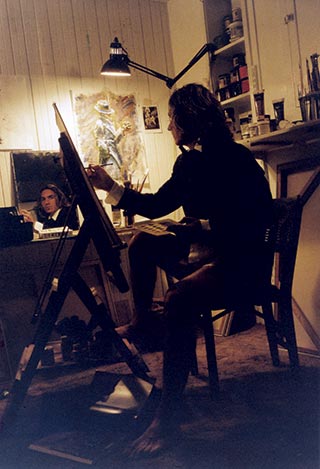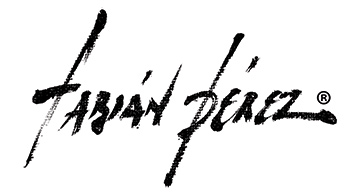 For Fabian Perez, the purpose of art is to perpetuate beauty. “That is what I am always striving for. God created the world and embellished it with the wonders of nature. I think it is the artist’s job to embellish it with his work.”
For Fabian Perez, the purpose of art is to perpetuate beauty. “That is what I am always striving for. God created the world and embellished it with the wonders of nature. I think it is the artist’s job to embellish it with his work.”
“I am constantly fighting for a more romantic world, one where the woman and the man have defined roles and power isn’t always the goal.” Pausing, he says, “I would like to say that it is not important what you have, but how you enjoy it.”
Born in 1967 in Buenos Aires, Argentina, Fabian had a difficult childhood. His father owned bordellos and nightclubs that were illegal. He also was a gambler. To this day, Fabian remembers the police coming to their home looking for his father who would try to escape through the back door. “So many times he went to jail. I remember when I was very young going to police stations and looking for him.” Eventually his father gave up the business, lost everything and lapsed into depression.
Meanwhile, Fabian’s mother, who was artistic herself, encouraged her son to develop his aptitude for art. From an early age he loved to draw and she would proudly display these endeavors. He was also passionate as a boy about soccer and martial arts—the latter becoming an integral part of his life and his work as an artist. “I remember at the age of 11 quitting my first class because there was a World Cup soccer match. I did not take art classes in school, or even finish high school, but when the teachers wanted a drawing of, say, an Argentine hero, they always came to me.” As a young adult, he did decide to take a few art courses to learn more about the true craft of drawing and painting, but it was never formal training.
It is imagery from his past that he draws from in his painting, his father his inspiration. He is the cool guy outside the nightclubs and bordellos in Fabian’s images. And the women are his memories of those he saw at his father’s brothels and nightclubs—their somber mood, brooding thoughts and intense sensuality emanating from his canvases. But that is now. For several years after his parents died, his mother when he was 16, his father when he was 19, he lived as a gypsy. The sadness and despair he experienced left him confused and searching for answers. It was in martial arts that he found an inner strength. He immersed himself in the discipline.
Alone and struggling to take care of himself, he began to teach karate while living in martial arts studios or friends’ homes. It was then that he crossed paths with a Japanese karate master, Oscar Higa, who became his teacher, mentor, friend and father figure. For a while, Fabian spent time in Rio; living the life of a nomad, finding refuge on warm beaches. Then he collected himself, deciding to follow Oscar to Italy. It was there, in the small town of Padova outside Venice, that he began his career as an artist. “What painting means to me,” he says, “is that I escape from the world I don’t like. I feel so comfortable doing it.” European tourists liked his work. Fabian began having small exhibitions. He spent his time painting and teaching martial arts, the latter to support himself. His dream was to become a karate master.
After seven years in Italy, where he traveled frequently, giving martial arts exhibitions, he moved to Japan and continued to teach karate, not realizing that martial arts would become such an influence in his painting technique and, indeed, in his life’s path.
Inspired by the Shodo, he utilized this influence to combine figurative and abstract styles. Shodo is often practiced by Samurais and Buddhist monks. It is as much a discipline as an art form. “With Shodo,” Fabian explains, “one sits on the floor with a sheet of rice paper, a brush and Chinese ink. The artist begins to concentrate and, when he feels ready or the urge strikes, he starts to paint. When a stroke is made on the paper, the artist cannot turn back. If he is unhappy with what he has created, he must start all over. Even when I’m going backward and forward with my colors, the important thing is the determination of each stroke.”
The influence of artists such as Lautrec, Picasso, Sargent and Cezanne are felt in Fabian’s work. “But in the end it is my own,” he says.
Today, Fabian has a studio in Los Angeles, where he also lives with his wife, Luciana and his three children. She is in many of his paintings. “For her, nothing is impossible. If I wish for something, she will try to make it possible for me.”
Mostly he works in the mornings and early afternoon, when the light is best. Usually he uses acrylic paint, so that he doesn’t have to wait for it to dry. “My paintings are dark, because I try to only give an idea. Not every detail. I prefer to paint the moods in color, so the viewer gets a sense of what is being felt. Painting is a wonderful way of communicating with people. It can be hard to explain everything that I feel and, in some way, people understand when they look at my art better than I could ever say it.”
He likens painting to music and this is particularly evident in his Flamenco pieces, where the dancer creates complex rhythmic patterns. “I compare color and technique with music and rhythm, the subject matter and composition with lyric and poetry. I want to invite the viewer to remain in front of my paintings, not feel rejected by them. The longer they linger, the better my chance to communicate with them. When music is gentle, people will listen to it. I take things that people like to look at and then they see more deeply into it.”
The scenes from his youth in Argentina reflect a time that, in his view, is more romantic than the present day. “A time when the man would take pride in shaving or simply fixing his tie. And the woman would follow a routine of slow and sensual movements, seducing a man just by lighting a cigarette.”
